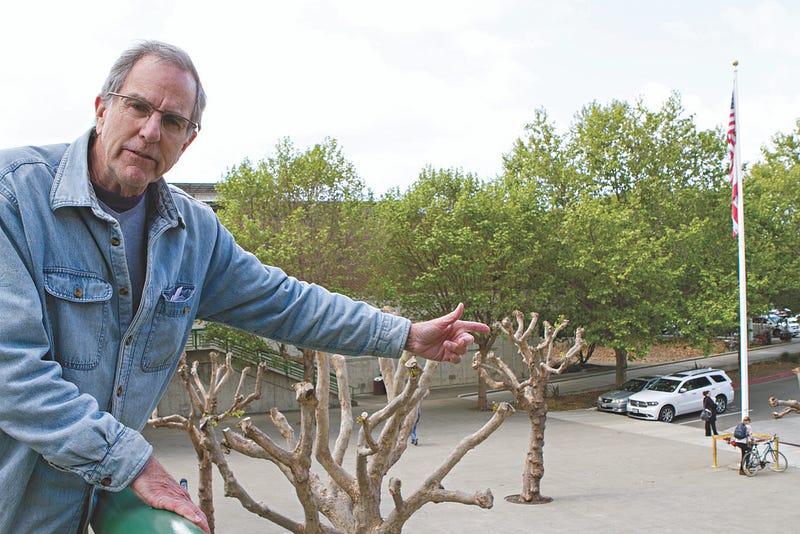Laney trees have been trimmed to nubs in order to allow better views for campus security cameras. One professor wonders why.
By Eva Hannan

London Planetrees abound on the Laney College campus. Pale, smooth bark and broad pointy leaves distinguish these tall deciduous trees, which are planted at the entrance to the school and along 8th Street between the campus and the student parking lot.
During the month of March, 42 of these trees were dramatically trimmed in a technique called “pollarding,” which emerged in the middle ages as an aesthetic practice to make certain trees resemble candelabras.
The practice also keeps trees from growing past a certain height, since the new growth is regularly pruned. Typically, this practice is performed when the trees are dormant in the winter.
Professor Mark Rauzon, who teaches geography at Laney, has voiced concern that the trimming was detrimental to the quality of air on campus.
“Why are we wasting time and fuel and removing a green canopy when we are relying on these trees to provide an air pollution screen from the freeway?” he said.
Besides blocking dust and absorbing air pollution from the 250,000 cars that pass by on Interstate 880 each day, the trees also provide shade for the campus.
“You’re inviting a hotter, drier, more polluted campus by doing this,” Rauzon said.
Peralta Vice Chancellor of General Services Sadiq Ikharo agreed that the timing of the pruning was unfortunate.
“Several years ago the district regularly trimmed all parking lot trees using professionals with proper equipment to do their job,” he said.
Students and faculty requested Students and faculty requested that the district allow trees to grow, so the practice was stopped.
Since that time, the trees grew so tall they blocked the cameras the Peralta Police Services use for a live video stream to monitor the campus.
“This time, the Department of General Services received a request from the Peralta Sheriff’s Department that the foliage was overgrown and blocking the cameras at the front of the school and in the parking lot,” Ikharo said.
Ikharo said he was disappointed to hear that the trees may have been trimmed improperly, but student safety and protecting property had to take precedence to environmental concerns.
Rauzon is concerned the trees may present an out-of-the-pan-and-into-the-fire-type scenario for the school.

The way the trees were cut, much of the foliage may never grow back, and the dead branches are avenues for disease in the tree.
“The improper way it’s been done is increasing the potential for future decay and weakness,” Rauzon said. “This branch is not gonna come back. With the pollarding, you get a knob like this and you’re only supposed to cut the branches that are coming out.”
Ikharo is taking a wait-and-see approach to concerns that many of the trees will never grow back.
“We made arrangements with the [Laney] grounds department staff,” he said. “They know how to trim trees but they may have been without the proper equipment to do their job.”

If any trees or branches die, they pose the threat of falling on people and property.
“The district plans to replace any trees that do not grow back again,” Ikharo said. “Give it some time, and if necessary the district will hire an arborist to remove and replace the trees.”
The trimming has already proved effective to reduce crime on campus, he said, particularly in the student parking lot.
“The number of break-ins has reduced dramatically…dramatically. Which means it was effective,” he said.
Eva Hannan is a Laney Tower staff writer

























